Le seigneur des conteneurs
Un atelier de migration vers Kubernetes et Traefik


How to use these slides?
Browse the slides: Use the arrows
Change chapter: Left/Right arrows
Next or previous slide: Top and bottom arrows
Overview of the slides: keyboard’s shortcut "o"
Speaker mode (and notes): keyboard’s shortcut "s"
Whoami 1/2
Nicolas Mengin
DevOps & Code Craftsman @ Containous
Blacksmith on Traefik

Whoami 2/2
Damien DUPORTAL
Traefik's Developer 🥑 Advocate @ Containous

Containous
We Believe in Open Source
We Deliver Traefik
Commercial Support for Traefik
20 people, 90% tech
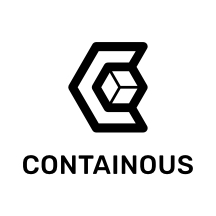
Once Upon a Time…
An Infrastructure War
Docker as a standard
Orchestrators: Docker Swarm, Rancher Caddle, Mesos Marathon, Kubernetes…
The war lasted a couple of years…
One orchestrator to rule them all
Kubernetes
Used by the competition
Standard in the industry
Powerful but not easy to master
Menu
The Hobbit House: Introduction to Traefik with Docker
Break
Saruman Tower: Migrate Traefik to Kubernetes
Break
The Castle: Migrate the infrastructure to Kubernetes
The Hobbit House

The Blacksmith
We want to host:
Our web site
Our own SCM Server,
Our own Continous Integration,
and a "web" command line.
Preparation
Step 1: Access the spreadsheet at https://bit.ly/2Pdfe41
Step 2: Select a line and put your name to allocate the VM
Step 3: no Step 3!
Infrastructure Setup
An online shell to reach the lab infrastructure via SSH
A public domain name
lab-XX.ddu-workshops-Y.comfor your stackA VM in the cloud, to run your "legacy" Dockerized applications
Connect to it from the WebCLI with
ssh 10.0.x.y
Docker and docker-compose installed on the "Docker" VM
Create a directory named
~/01-dockeras working directory
DNS Setup
Connect to the "Blue-Green Jenkins":
Link: Blue-Green Jenkins
Login with username
devoxxand passwordgandalf
Run the Job "change-dns"
Link: Job "change-dns"
Specify the
EXTERNAL_HOSTNAMEof your lab (labXX.ddu-workshops-Y.com)Specify the
BACKEND_IPof your Docker VM (10.0.x.y)
Reality Check
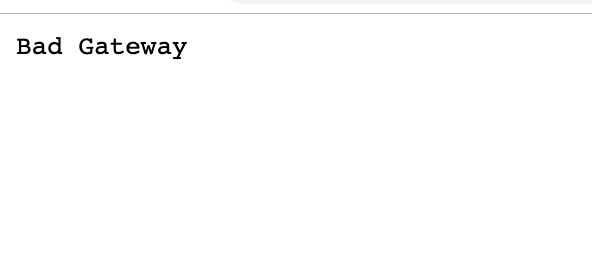
The external loadbalancer cannot reach our VM.
Lab 1

Traefik
Web Server
CI Server
SCM: A Gitea Git Server
Web CLI
SSL for everyone
Why Traefik?

Why, Mr Anderson?
Evolution of Software Design
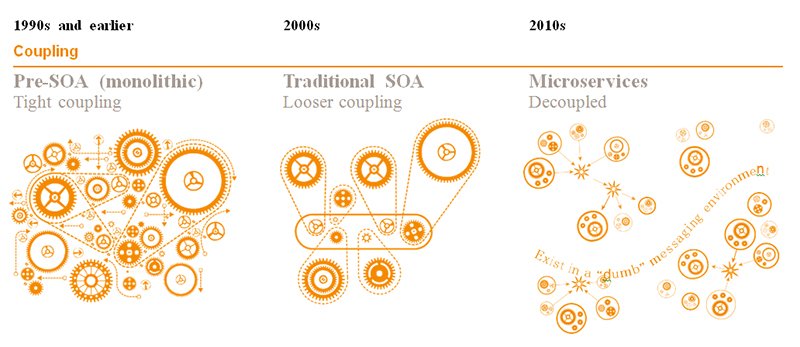
The Premise of Microservices…

…and What Happens

Tools of the Trade














Where’s My Service?

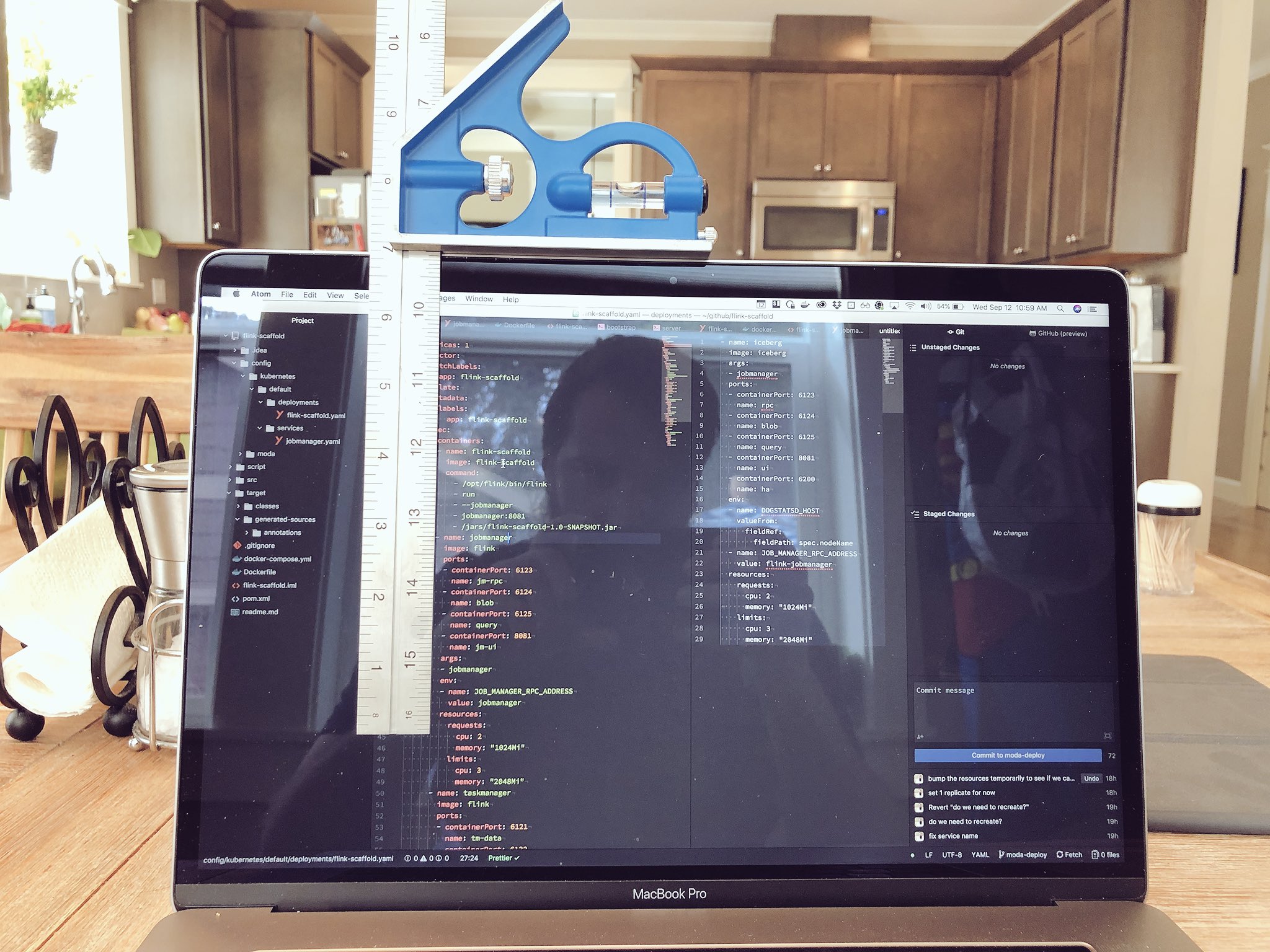
What If I Told You?

That You Don’t Have to Write This Configuration File…?
Here Comes Traefik!
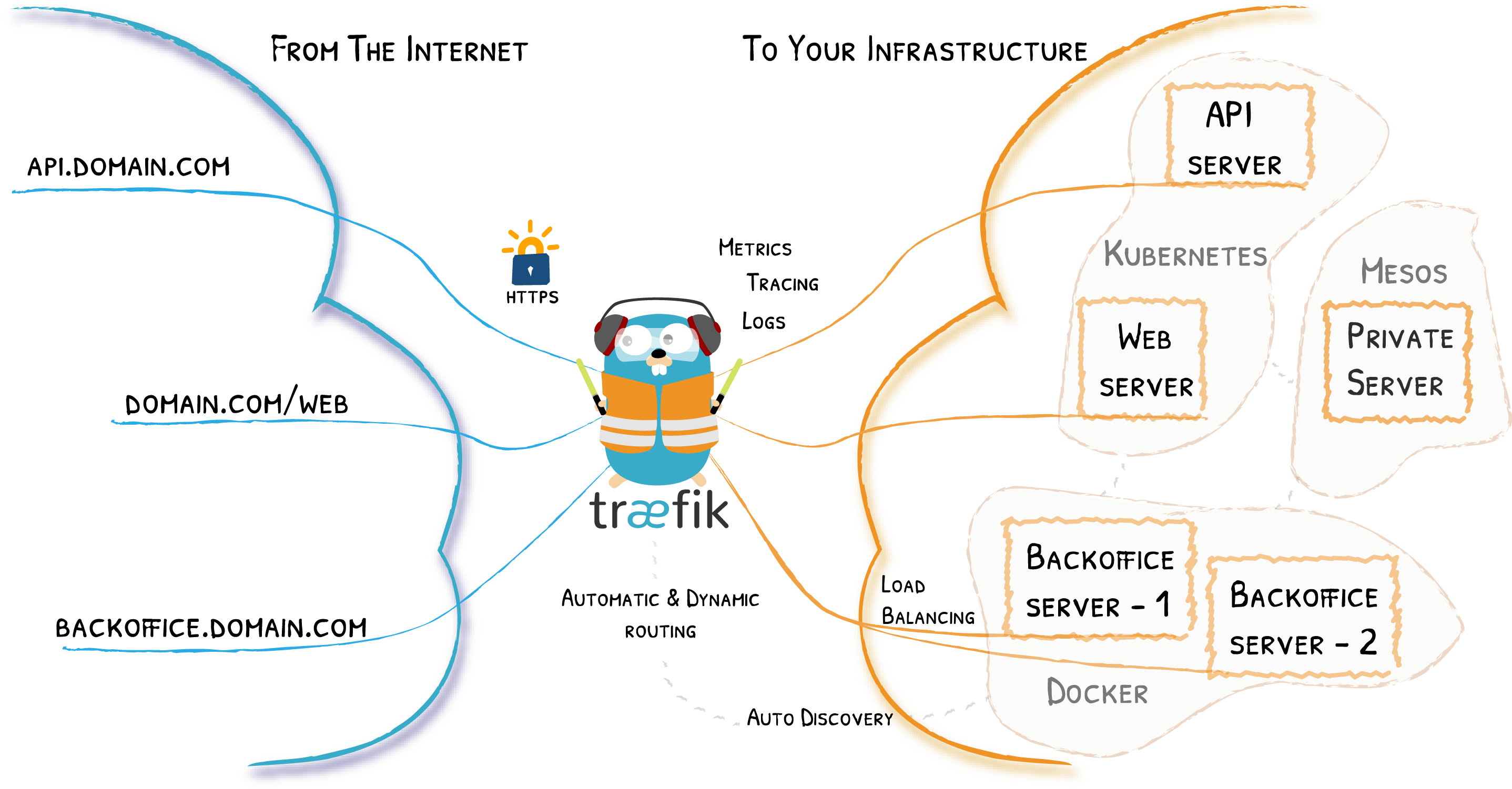
Traefik Project
MIT License
Written in Go
21,000+ ⭐
600M+ ⬇️
350+ 👷
Remember the Diagram?

Let’s Simplify

Providers

Entrypoints
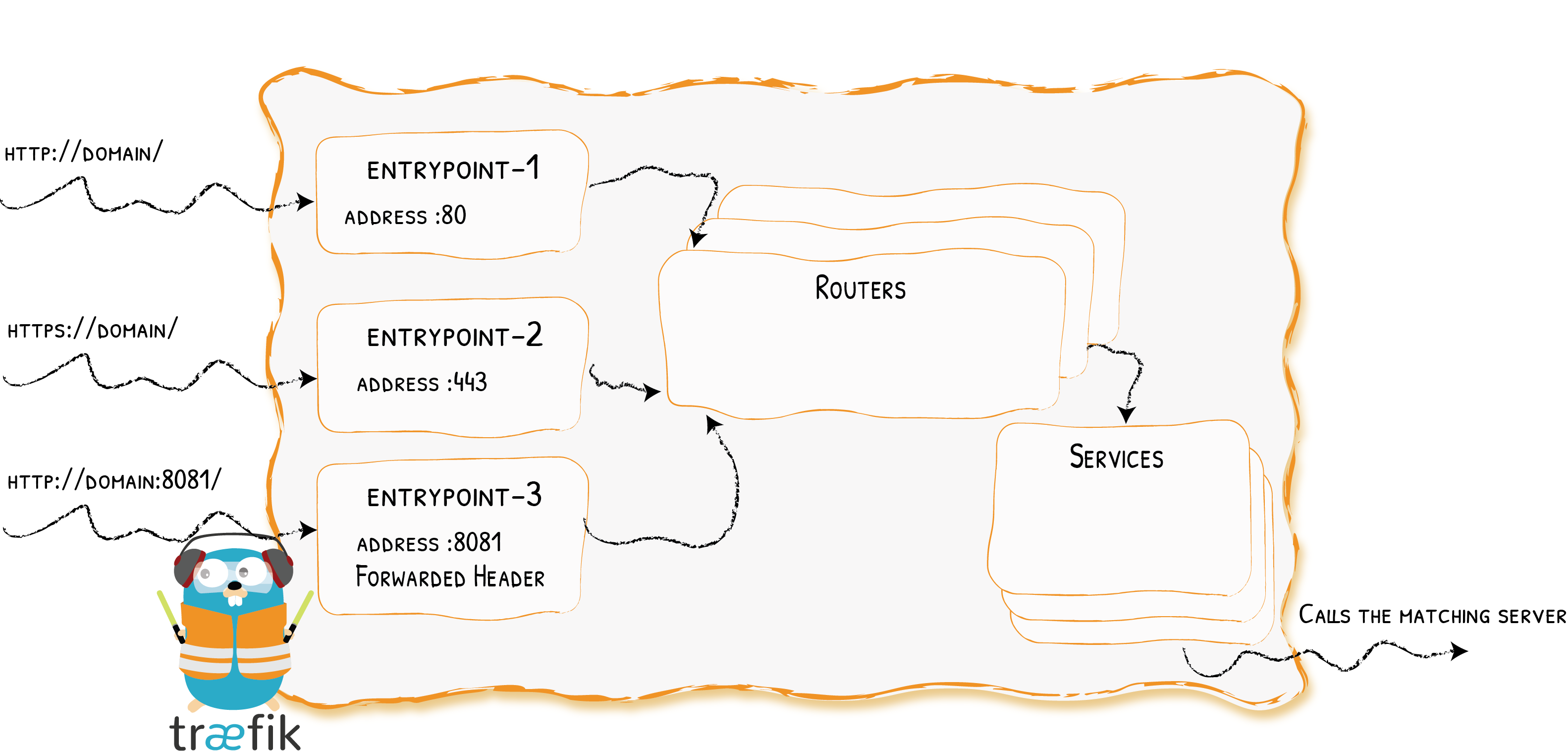
Backends
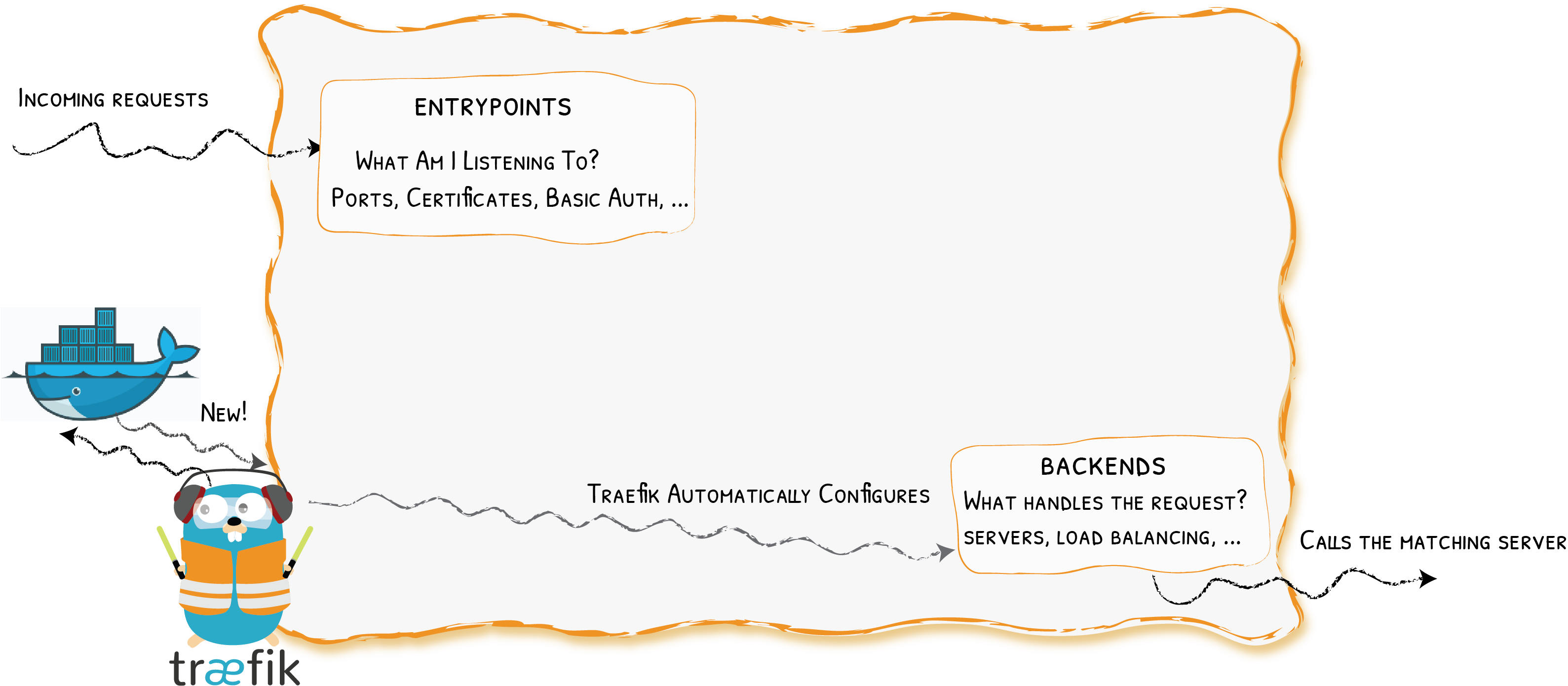
Frontends
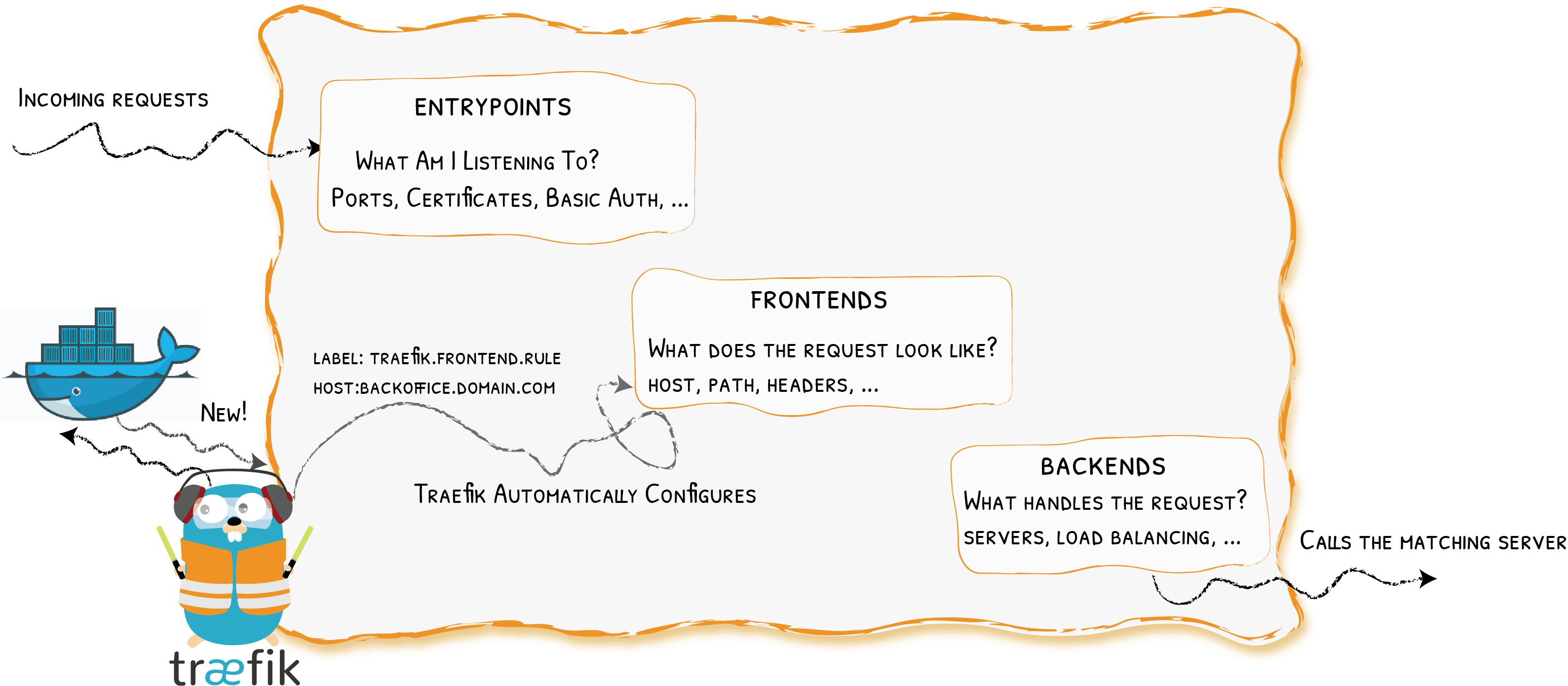
At a Glance
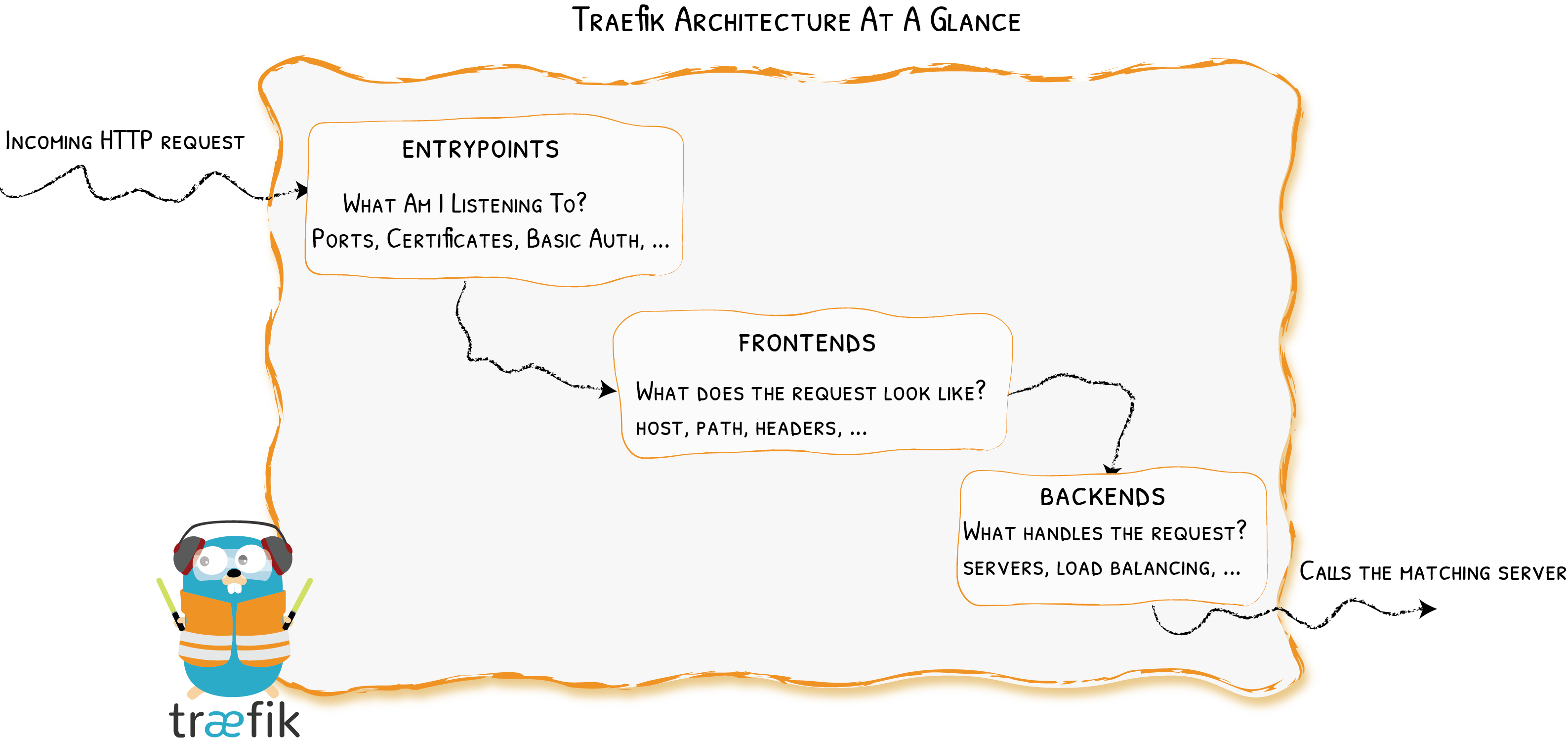
In Practice
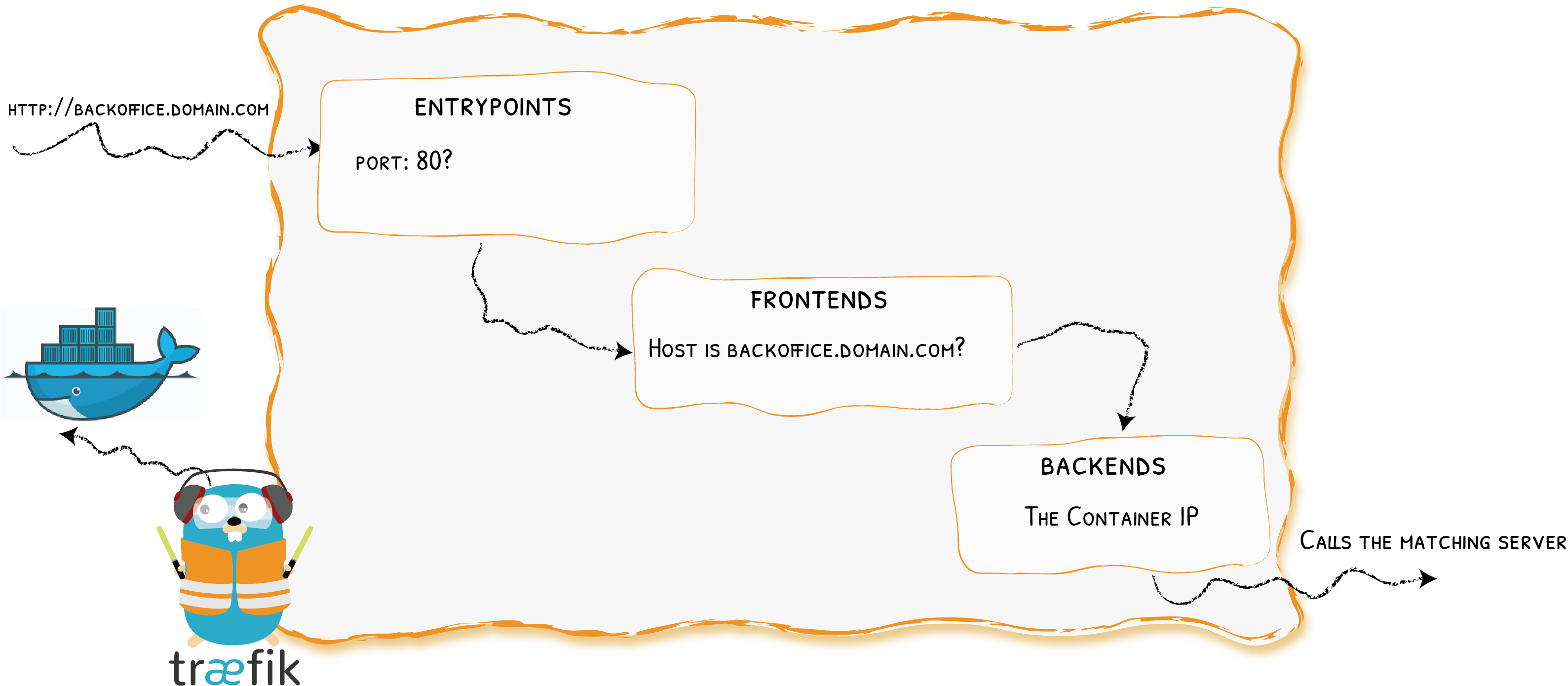
Let’s Go
Traefik Setup
Step 1: Compose file in
/home/devoxx/01-docker/docker-compose.yml:version: '2.4' services: edge: image: traefik:1.7.10 command: - "--docker.domain=lab-XX.ddu-workshops-Y.com" ports: - "80:80" - "443:443" volumes: # To communicate with the Docker Engine - /var/run/docker.sock:/var/run/docker.sockStep 2: Start the stack:
docker-compose up -d
Reality Check
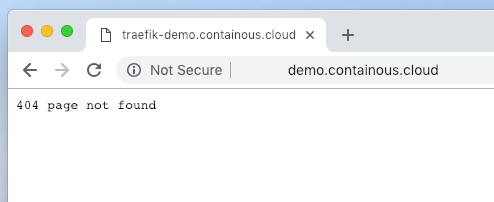
It’s good: we have an HTTP answer!
Lab 1

Traefik
Web Server
CI Server
SCM: A Gitea Git Server
Web CLI
SSL for everyone
Goal
We want to host a static webserver behind Traefik.
Problem
How to tell Traefik to route requests to the web server?
http://lab-XX.ddu-workshops-Y.com/index.html
-> Traefik
-> http://<Webserver Private IP>/index.htmlThe Web Server Setup
Step 1: web server in Compose. Check the
labels:
web:
image: nmengin/web:devoxx-v1
labels:
- "traefik.frontend.rule=PathPrefix:/"Step 2: Start the Web Server:
docker-compose up -d webReality Check
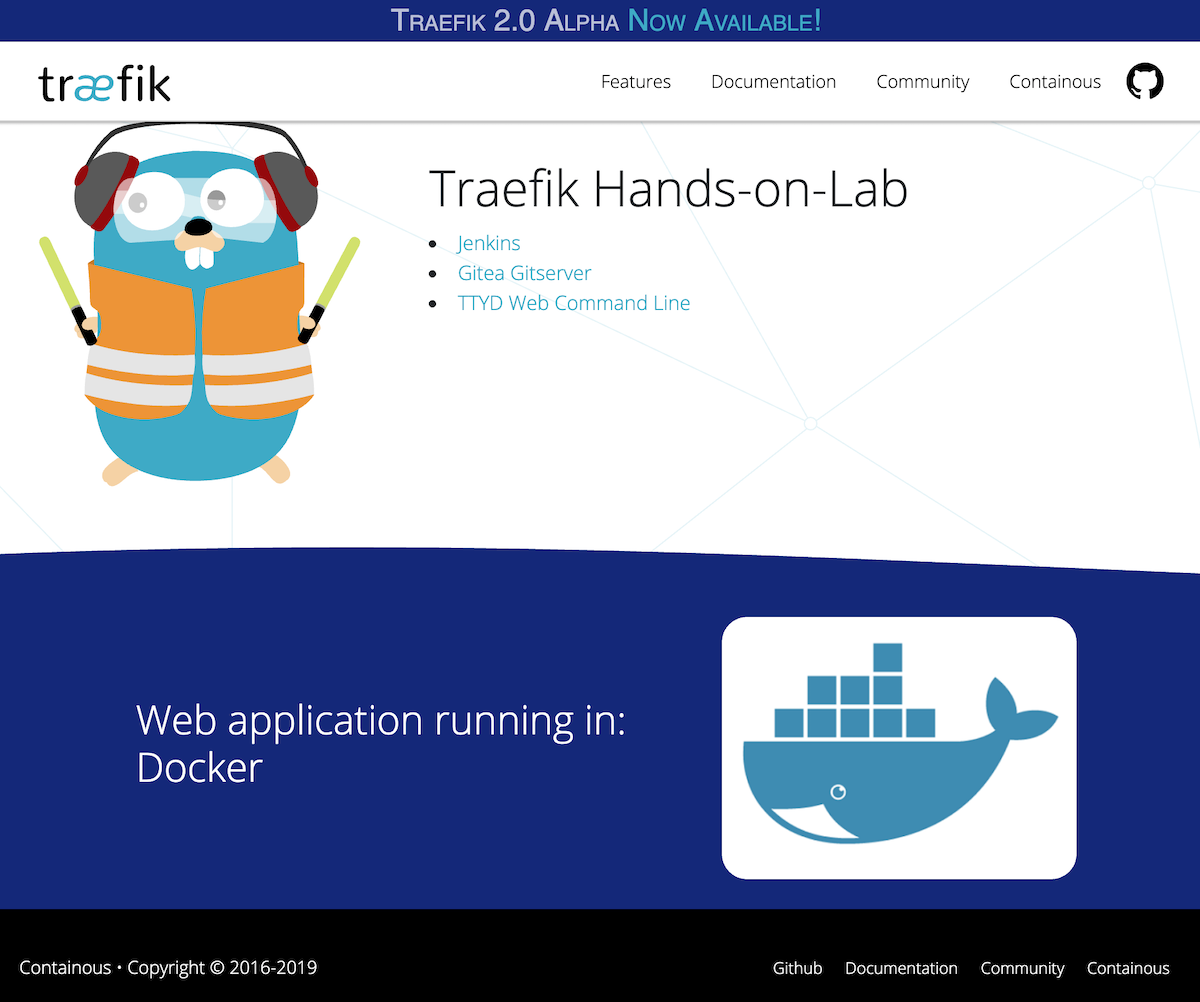
It’s good: we have a web page!
Lab 1

Traefik
Web Server
CI Server
SCM: A Gitea Git Server
Web CLI
SSL for everyone
Goal
We want to host our own automation system for Continuous Integration
Let’s use Jenkins
Challenge 1/3
Problem: Jenkins exposes 2 ports:
8080and50000. How to let Traefik know to only use8080?Solution: Select the port with the label
traefik.port.- "traefik.port=8080"
Challenge 2/3
Problem: How to let Traefik know when to send requests to the Jenkins backend instead of the webserver?
http://lab-XX.ddu-workshops-Y.com/jenkins/configuration -> Traefik -> http://<Jenkins Private IP>:8080/jenkins/configurationSolution: Change the frontend rule to use
PathPrefix.- "traefik.frontend.rule=PathPrefix:/jenkins"
Challenge 3/3
Problem: How to tell Jenkins to accept requests under
/jenkins?Solution: Use the Jenkins flag
--prefix=/jenkinswith the variableJENKINS_OPTS.environment: - JENKINS_OPTS=--prefix=/jenkins
Jenkins Setup
Step 1: Edit Compose file:
jenkins:
image: jenkins/jenkins:2.164.2-alpine
expose:
- 8080
- 50000
environment:
- JENKINS_OPTS=--prefix=/jenkins
labels:
- "traefik.port=8080"
- "traefik.frontend.rule=PathPrefix:/jenkins"Step 2: start the service:
docker-compose up -d jenkinsReality Check

It’s good: we can setup Jenkins!
Lab 1

Traefik
Web Server
CI Server
SCM: A Gitea Git Server
Web CLI
SSL for everyone
Goal
We want to host our own git server
Challenge
Problem:
Gitea only serves requests under
/:How to remove the prefix
/gitserver?http://lab-XX.ddu-workshops-Y.com/gitserver/index.html -> Traefik -> http://<Gitea private IP>:3000/index.html
Solution: Use the Traefik Frontend Rule
PathPrefixStrip.- "traefik.frontend.rule=PathPrefixStrip:/gitserver"
Gitea Setup
Step 1: Edit Compose file:
gitserver:
image: gitea/gitea:latest
expose:
- "3000"
- "22"
environment:
- ROOT_URL=/gitserver
labels:
- "traefik.port=3000"
- "traefik.frontend.rule=PathPrefixStrip:/gitserver"Step 2: Create the service:
docker-compose up -d gitserverReality Check
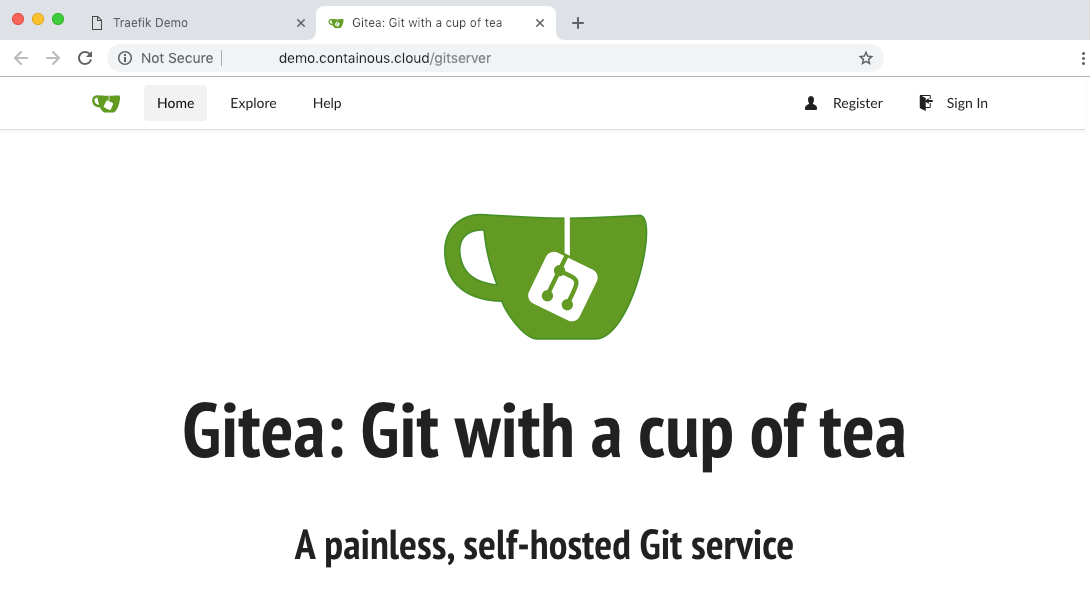
It’s good: we can setup Gitea!
Lab 1

Traefik
Web Server
CI Server
SCM: A Gitea Git Server
Web CLI
SSL for everyone
Goal
We want to host our own Web Command Line.
Let’s use TTYD, Share your terminal over the web.
Challenge
Problem: TTYD requires Websockets.
Solution: It’s not even a problem with Traefik!
Easy Peasy!
Step 1: Edit Compose file:
ttyd:
image: tsl0922/ttyd:1.4.2-alpine
labels:
- "traefik.frontend.rule=PathPrefixStrip:/ttyd"Step 2: Create the service:
docker-compose up -d ttydReality Check
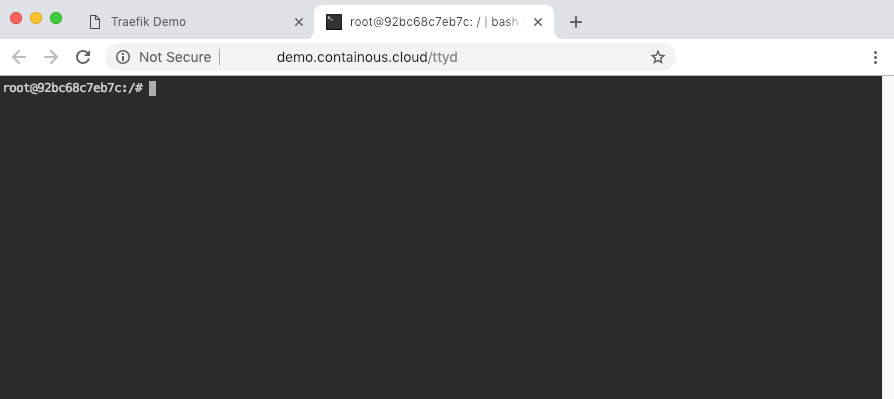
It’s good: we have our own "web CLI" in a web browser!
Lab 1

Traefik
Web Server
CI Server
SCM: A Gitea Git Server
Web CLI
SSL for everyone
Goals
Use HTTPS instead of HTTP
Do NOT care about certificates and renewal
Use a TOML configuration file
Let’s Encrypt is a free, automated, and open Certificate Authority.
It uses the "ACME" protocol to verify that you control a given domain name and to issue a certificate.
Problem 1/3
Problem: How to tell Traefik to listen on port
443for HTTPS requests?Solution:
Create a new entrypoint
Add it to the default entrypoints list
# TOML sample
defaultEntryPoints = ["http", "https"]
[entryPoints]
[entryPoints.https]
address = ":443"
[entryPoints.https.tls]Problem 2/3
Problem: How to tell Traefik to use Let’s Encrypt for HTTPS?
Solution:
Configure the ACME/Let’s Encrypt provider:
# TOML sample
[acme]
email = "noreply@lab.org"
storage = "/acme/acme.json"
entryPoint = "https"
# caServer = "https://acme-staging-v02.api.letsencrypt.org/directory"
[acme.tlsChallenge]
[[acme.domains]]
main = "lab-XX.ddu-workshops-Y.com"Problem 3/3
Problem:
Traefik detects itself as a docker container with a port
It tries to request a 2nd certificate for
edge.lab-XX.ddu-workshops-Y.com.
Solution: Exclude Traefik’s container with the label
traefik.enable=false.
Traefik Setup 1/2
Step 1: Create the configuration file
traefik.toml:
defaultEntryPoints = ["http", "https"]
[entryPoints]
[entryPoints.https]
address = ":443"
[entryPoints.https.tls]
[entryPoints.http]
address = ":80"
[acme]
email = "noreply@lab.org"
storage = "/acme/acme.json"
entryPoint = "https"
# caServer = "https://acme-staging-v02.api.letsencrypt.org/directory"
[acme.tlsChallenge]
[[acme.domains]]
main = "lab-XX.ddu-workshops-Y.com"
[docker]
domain = "lab-XX.ddu-workshops-Y.com"
watch = trueTraefik Setup 2/2
Step 2: Adapt the Compose file:
edge:
image: traefik:1.7.10
labels: # Replace "command" by labels
- "traefik.enable=false"
ports:
- "80:80"
- "443:443"
volumes:
- /var/run/docker.sock:/var/run/docker.sock
# Add the TOML configuration file in the root directory
- ./traefik.toml:/traefik.toml
# We declare the folder "/acme" as a data volume
- /acmeStep 3: Update the
edgeservice:
docker-compose up -d edgeReality Check
Wait a few seconds (time to get the certificate from Let’s Encrypt) and reload the main page:
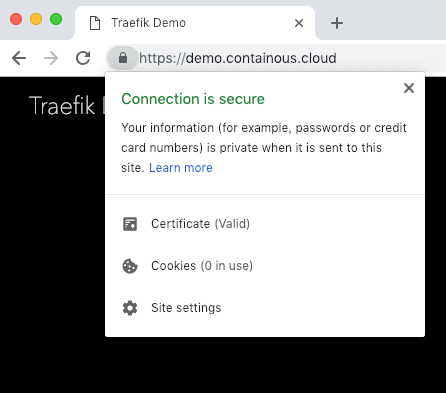
Saruman Tower: Migrate Traefik To Kubernetes

Saruman Tower
We want to begin the migration of our services from the our VM to a Kubernetes cluster:
keep the Docker services
migrate Traefik to Kubernetes
migrate the Let’s Encrypt certificates
access to the Docker services through Traefik in Kubernetes
Infrastructure Setup
A Kubernetes cluster (k3s) on a 2nd VM
Get the IP on the spreadsheet (column "Kube IP (10.0.n.p)")
Connect to the VM with the webshell:
ssh 10.0.n.p
kubectlandhelminstalled on the client machinesCreate a directory named
~/02-k8s-traefikas working directory
Kubernetes Cheat Sheet
Kubernetes Official Documentation:
kubectlcheat sheet:Get status of an object:
# Use the -o yaml for full readable description kubectl get --namespace=devoxx <object type> <object name> (-o yaml)An error after a
kubectl apply? Do a properkubectl delete
Lab 2

Traefik
Web Server
CI Server
SCM: A Gitea Git Server
Web CLI
North-South connection in Kubernetes
Internet
|
[ Ingress ]
--|-----|--
[ Services ]
--|-----|--
[ Pods ]
Remember the Diagram?

In Kubernetes
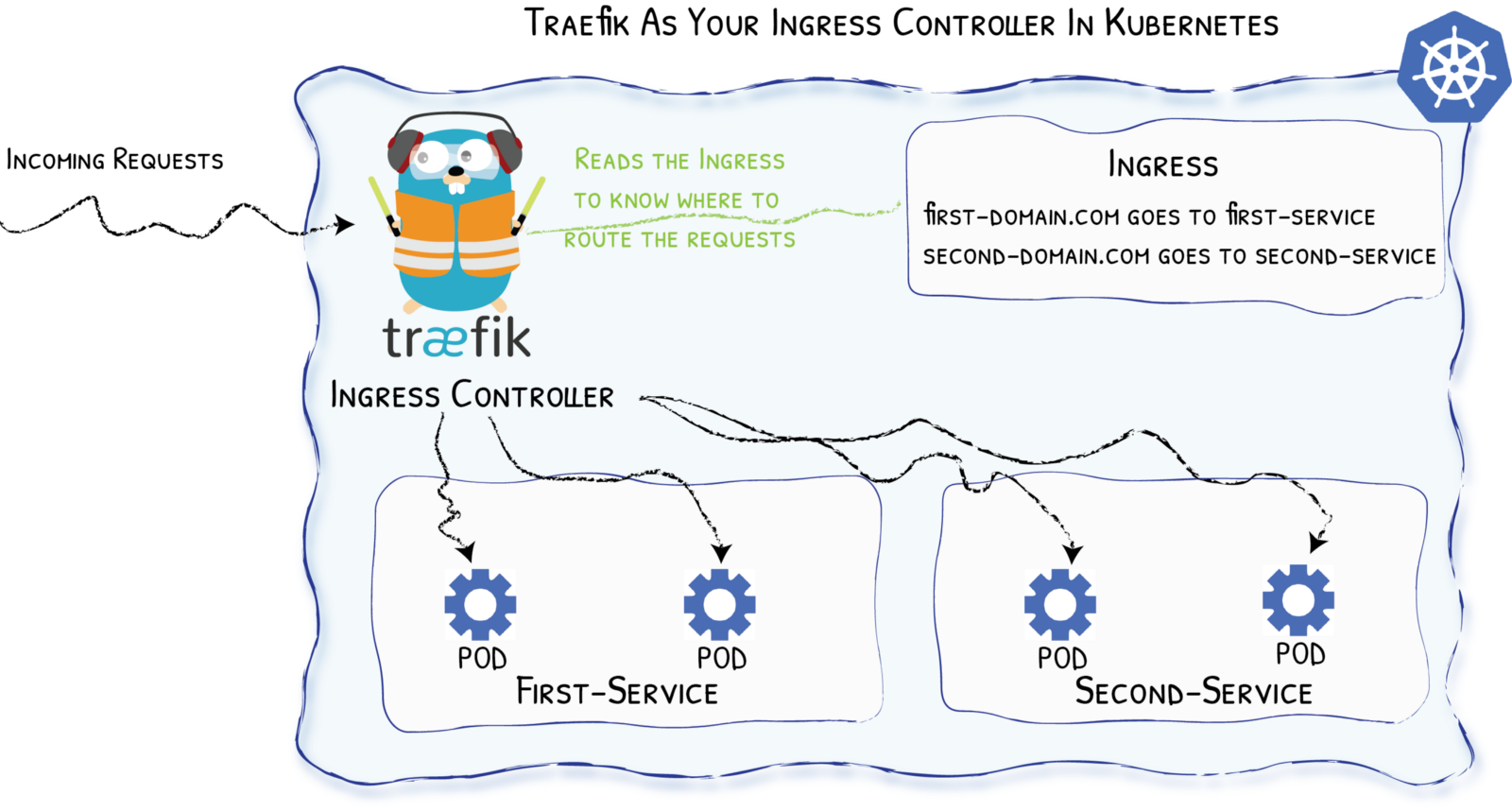
Let’s Go
Let’s start by migrating the Let’s Encrypt Certificates
Then, we install Traefik as Ingress Controller
Goal
We want to use our generated Let’s Encrypt certificates.
We do not want to exceed the ACME Rate Limits..
Retrieve Certificates from Docker
Step 1: From the "Legacy" (Docker) VM:
# Get Traefik Container ID
TRAEFIK_CONTAINER_ID="$(docker ps | grep traefik | grep edge | awk '{print $1}')"
# Generate a file "certs.b64" in the user home
docker run --rm --volumes-from="${TRAEFIK_CONTAINER_ID}" -t \
alpine cat /acme/acme.json | base64 > ~/certs.b64Step 2: From the "bastion", copy the certificates to the new VM
ssh 10.0.x.y cat certs.b64 | ssh 10.0.n.p "cat > certs.b64"Import Certificates into Kubernetes
On the "Kube" VM, we’ll create a pod with a PVC ("Persistent Volume Claim").
Then, using this pod, we’ll populate the persistent volume with the
acme.jsondata.After that, we’ll be able to install the Traefik Ingress configured to use this PVC.
Prepare PVC in Kubernetes
Step 1: Create the PVC ("Persistent Volume Claim") manifest file
acme-pvc.yml:apiVersion: v1 kind: PersistentVolumeClaim metadata: name: acme-data-pvc namespace: devoxx spec: accessModes: - ReadWriteOnce storageClassName: local-path resources: requests: storage: 200MiStep 2: create namespace and PVC:
kubectl create namespace devoxx kubectl apply -f acme-pvc.yml
Prepare the "acme-loader" Deployment
Step 1: Create the manifest file
acme-deploy.yml:apiVersion: v1 kind: Pod metadata: name: acme-loader namespace: devoxx spec: containers: - name: acme-loader image: traefik:alpine imagePullPolicy: IfNotPresent volumeMounts: - name: acme mountPath: /acme volumes: - name: acme persistentVolumeClaim: claimName: acme-data-pvcStep 2: create the deployment:
kubectl apply -f acme-deploy.yml
Load ACME data in Kubernetes
Step 1: Wait for the pod and pvc to be created:
# Expecting the pod "acme-loader" to be in state "Running" watch kubectl get pod,pv,pvc --namespace=devoxx # Then hit CTRL-CStep 2: Decode ACME data and copy it:
base64 --decode certs.b64 > ~/acme.json chmod 0600 ~/acme.json kubectl --namespace=devoxx cp ~/acme.json acme-loader:/acme/ kubectl exec --namespace=devoxx acme-loader -- ls -l /acme # the file "acme.json" MUST be in 600 (-rw-------)Step 3: Remove the "acme-loader" deployment:
kubectl delete -f acme-deploy.yml
Install Traefik Ingress
Create a values.yml file
Step 1: Add rights on namespace:
# Allow creating the needed Role and Service Account rbac: enabled: trueStep 2: Set SSL EntryPoint with redirection:
ssl: enabled: true enforced: trueStep 3: Add Let’s Encrypt:
acme: enabled: true email: noreply@lab.org onHostRule: true #staging: true challengeType: tls-alpn-01 persistence: enabled: true existingClaim: acme-data-pvc
Deploy Traefik
helm install stable/traefik \
--name traefik-devoxx \
--namespace devoxx \
--set imageTag=1.7.10 \
--values values.ymlAccess to Traefik
Step 1: Run the command:
kubectl --namespace=devoxx get servicesStep 2: Once the column
EXTERNAL-IPshow an IP in172…, then the LoadBalancer can be reached at your VM’s IP address:# Launch a curl command from the Kube VM curl -v 10.0.n.p # 302 Found -> https://10.0.n.p
Reality Check
It’s good: we have an anwser: HTTP/302 redirect to https!
Lab 2

Traefik
Web Server
CI Server
SCM: A Gitea Git Server
Web CLI
Goal
We want access to the webserver hosted in Docker through Traefik in Kubernetes.
Challenge 1/2
Problem: How to tell to Traefik to route requests to the web server which is not deployed in Kubernetes?
https://lab-XX.ddu-workshops-Y.com/index.html
-> Traefik Kubernetes
-> Traefik Docker
-> https://<Webserver Private IP>/index.htmlHeadless Service
Solution: Define a service linked to an external address in ~/02-k8s-traefik/web.yml.
---
apiVersion: v1
kind: Service
metadata:
name: web-service
namespace: devoxx
labels:
guilde: web
spec:
ports:
# Define the port to contact on the external Host
# Here contact Traefik defined in lab1
- port: 80
name: traefik-http
# Indicate to Kubernetes that the service will redirect
# to a backend which is not managed in the Kubernets network
type: ExternalName
# IP of the VM in the lab1
externalName: 10.0.x.yChallenge 2/2
Problem: How to detect the HTTPS requests to catch?
Ingress Rule
Solution: Define a rule to catch all the incoming resquests for the PathPrefix:/ in ~/02-k8s-traefik/web.yml.
---
apiVersion: extensions/v1beta1
kind: Ingress
metadata:
name: web-ingress
namespace: devoxx
labels:
guilde: web
annotations:
kubernetes.io/ingress.class: 'traefik'
traefik.frontend.passHostHeader: "false"
traefik.frontend.rule.type: PathPrefix
spec:
rules:
- host: lab-XX.ddu-workshops-Y.com
http:
paths:
- path: /
backend:
serviceName: web-service
servicePort: traefik-httpApply the configuration
Step 1: Apply the Kubernetes manifest:
kubectl apply -f ~/02-k8s-traefik/web.ymlStep 2: Verify locally:
curl -v -sSL 10.0.n.p -H "Host: lab-XX.ddu-workshops-Y.com" > /dev/null # ... # HTTP/2 200 # ...Step 3: Use the Blue-Green Jenkins job to switch:
Your domain name (
labXX.ddu-workshops-Y.com)To this
VM_IP(10.0.n.p)
Reality Check

It’s good: we have a web page!
Lab 2

Traefik
Web Server
CI Server
SCM: A Gitea Git Server
Web CLI
Goal
We want access to the CI hosted in Docker through Traefik in Kubernetes
Challenge 1/2
Problem: How to tell to Traefik to route requests to the CI which is not deployed in Kubernetes?
https://lab-XX.ddu-workshops-Y.com/jenkins
-> Traefik Kubernetes
-> Traefik Docker
-> https://<Jenkins Private IP>/jenkinsHeadless Service
Solution: Use (once again) a service linked to an external address in ~/02-k8s-traefik/ci.yml.
---
apiVersion: v1
kind: Service
metadata:
name: jenkins-service
namespace: devoxx
labels:
guilde: ci
spec:
ports:
- port: 80
name: traefik-http
type: ExternalName
externalName: 10.0.x.yChallenge 2/2
Problem: How to detect the HTTPS requests to catch?
Ingress Rule
Solution: Define a rule to catch all the incoming resquests for the PathPrefix:/jenkins in ~/02-k8s-traefik/ci.yml.
---
apiVersion: extensions/v1beta1
kind: Ingress
metadata:
name: jenkins-ingress
namespace: devoxx
labels:
guilde: ci
annotations:
kubernetes.io/ingress.class: 'traefik'
traefik.frontend.passHostHeader: "false"
traefik.frontend.rule.type: PathPrefix
spec:
rules:
- host: lab-XX.ddu-workshops-Y.com
http:
paths:
- path: /jenkins
backend:
serviceName: jenkins-service
servicePort: traefik-httpApply the configuration
kubectl apply -f ~/02-k8s-traefik/ci.ymlReality Check

It’s good: we still can setup Jenkins!
Lab 2

Traefik
Web Server
CI Server
SCM: A Gitea Git Server
Web CLI
Goal
We want access to the Git server hosted in Docker through Traefik in Kubernetes.
Challenge 1/2
Problem:
Gitea only serves requests under
/Traefik in Docker already removes the prefix
/gitserver
http://lab-XX.ddu-workshops-Y.com/gitserver/index.html
-> Traefik Kubernetes
-> Traefik Docker
-> http://<Gitea private IP>:3000/index.htmlUse a PathPrefix rule
Solution: Do not remove the prefix (Thanks Captain Obvious!) in the ingress rule in ~/02-k8s-traefik/gitea.yml.
---
apiVersion: extensions/v1beta1
kind: Ingress
metadata:
name: gitea-ingress
namespace: devoxx
labels:
guilde: git
annotations:
kubernetes.io/ingress.class: 'traefik'
traefik.frontend.passHostHeader: "false"
# Only Path Prefix to let the other Traefik Strip it
traefik.frontend.rule.type: PathPrefix
spec:
rules:
- host: lab-XX.ddu-workshops-Y.com
http:
paths:
- path: /gitserver
backend:
serviceName: gitea-server
servicePort: traefik-httpChallenge 2/2
Problem: How to tell to Traefik to route requests to the SCM which is not deployed in Kubernetes?
Headless Service
Solution: Use (once again again) a service linked to an external address in ~/02-k8s-traefik/gitea.yml.
---
apiVersion: v1
kind: Service
metadata:
name: gitea-server
namespace: devoxx
labels:
guilde: git
spec:
ports:
- port: 80
name: traefik-http
type: ExternalName
externalName: 10.0.x.yApply the configuration
kubectl apply -f ~/02-k8s-traefik/gitea.ymlReality Check

It’s good: Gitea is still available!
Lab 2

Traefik
Web Server
CI Server
SCM: A Gitea Git Server
Web CLI
Goal
We want to access to TTYD deployed in Docker through Traefik in Kubernetes.
Challenges
Problem 1: How to tell to Traefik to route requests to TTYD which is not deployed in Kubernetes?
https://lab-XX.ddu-workshops-Y.com/ttyd -> Traefik Kubernetes -> Traefik Docker -> https://<WebCLI Private IP>/Problem 2: How to detect the HTTPS requests to catch ?
Solution 1
Use a Headless Service in
~/02-k8s-traefik/ttyd.yml:
---
apiVersion: v1
kind: Service
metadata:
name: ttyd-service
namespace: devoxx
labels:
guilde: console
spec:
ports:
- port: 80
name: traefik-http
type: ExternalName
externalName: 10.0.x.ySolution 2
Ingress Rule with
PathPrefix:/ttydin~/02-k8s-traefik/ttyd.yml:
---
apiVersion: extensions/v1beta1
kind: Ingress
metadata:
name: ttyd-ingress
namespace: devoxx
annotations:
kubernetes.io/ingress.class: 'traefik'
traefik.frontend.passHostHeader: "false"
traefik.frontend.rule.type: PathPrefix
spec:
rules:
- host: lab-XX.ddu-workshops-Y.com
http:
paths:
- path: /ttyd
backend:
serviceName: ttyd-service
servicePort: traefik-httpApply the configuration
kubectl apply -f ~/02-k8s-traefik/ttyd.ymlReality Check

It’s good: we can continue to develop in a web browser!
The Castle

The Castle
We want to terminate the migration of our services to the Kubernetes cluster.
Infrastructure Setup
Same VM as the Lab 2 (
ssh 10.0.n.pfrom the webshell)kubectlandhelminstalled on the client machinesCreate a directory named
~/03-k8s-appsas working directory
Lab 3

CI Server
SCM: A Gitea Git Server
Web CLI
Web Server
Goal
We want to host the CI in Kubernetes and access it through Traefik
Challenge 1/3
Problem: How to host the CI in Kubernetes?
Deployment Object
Solution: Declare it as a Deployment object in ~/03-k8s-apps/ci.yml.
---
kind: Deployment
apiVersion: extensions/v1beta1
metadata:
name: jenkins-full-deployment
namespace: devoxx
spec:
replicas: 1
template:
metadata:
labels:
guilde: ci
faction: jenkins
spec:
containers:
- name: jenkins-full-container
image: jenkins/jenkins:2.164.2-alpine
imagePullPolicy: IfNotPresent
env:
- name: JENKINS_OPTS
value: "--prefix=/jenkins"Challenge 2/2
Problem: How to access to the CI?
https://lab-XX.ddu-workshops-Y.com/jenkins
-> Traefik
-> https://<Jenkins Private IP>/jenkinsService
Solution: Adding a service in ~/03-k8s-apps/ci.yml.
---
apiVersion: v1
kind: Service
metadata:
name: jenkins-full-service
namespace: devoxx
labels:
guilde: ci
spec:
type: ClusterIP
ports:
- port: 8080
name: jenkins-http
- port: 50000
name: jenkins-agent
selector:
guilde: ci
faction: jenkinsIngress Rule
Solution: Adding an Ingress Rule in ~/03-k8s-apps/ci.yml.
---
apiVersion: extensions/v1beta1
kind: Ingress
metadata:
name: jenkins-full-ingress
namespace: devoxx
labels:
guilde: ci
annotations:
kubernetes.io/ingress.class: 'traefik'
traefik.frontend.rule.type: PathPrefix
spec:
rules:
- host: lab-XX.ddu-workshops-Y.com
http:
paths:
- path: /jenkins
backend:
serviceName: jenkins-full-service
servicePort: jenkins-httpApply the configuration
# Add the new objects
kubectl apply -f ~/03-k8s-apps/ci.yml
# Delete the headless service and its ingress rule (blue-green)
kubectl delete -f ~/02-k8s-traefik/ci.ymlReality Check

It’s good: we can setup Jenkins in Kubernetes!
Lab 3

CI Server
SCM: A Gitea Git Server
Web CLI
Web Server
Goal
We want to host the Git server in Kubernetes and access it through Traefik.
Challenges
Problem 1:
How to host the Git server in Kubernetes?
Problem 2:
Gitea only serves requests under
/Traefik in Docker already removes the prefix
/gitserver
http://lab-XX.ddu-workshops-Y.com/gitserver/index.html
-> Traefik
-> http://<Gitea private IP>:3000/index.htmlDeployment Object
Solution: Declare it as a Deployment object in ~/03-k8s-apps/gitea.yml.
---
kind: Deployment
apiVersion: extensions/v1beta1
metadata:
name: gitea-full-deployment
namespace: devoxx
spec:
replicas: 1
template:
metadata:
labels:
guilde: git
faction: server
spec:
containers:
- name: gitea-full-container
image: gitea/gitea:latest
imagePullPolicy: IfNotPresent
env:
- name: ROOT_URL
value: "/gitserver"Service
Solution: Adding a service in ~/03-k8s-apps/gitea.yml.
---
apiVersion: v1
kind: Service
metadata:
name: gitea-full-server
namespace: devoxx
labels:
guilde: git
spec:
type: ClusterIP
ports:
- port: 3000
name: gitea-http
- port: 22
name: gitea-ssh
selector:
guilde: git
faction: serverIngress Rule
Solution: Adding an Ingress Rule in ~/03-k8s-apps/gitea.yml.
---
apiVersion: extensions/v1beta1
kind: Ingress
metadata:
name: gitea-full-ingress
namespace: devoxx
labels:
guilde: git
annotations:
kubernetes.io/ingress.class: 'traefik'
traefik.frontend.rule.type: PathPrefixStrip
spec:
rules:
- host: lab-XX.ddu-workshops-Y.com
http:
paths:
- path: /gitserver
backend:
serviceName: gitea-full-server
servicePort: gitea-httpApply the configuration
# Add the new objects
kubectl apply -f ~/03-k8s-apps/gitea.yml
# Delete the headless service and its ingress rule (blue-green)
kubectl delete -f ~/02-k8s-traefik/gitea.ymlReality Check

It’s good: we can setup Gitea in Kubernetes!
Lab 3

CI Server
SCM: A Gitea Git Server
Web CLI
Web Server
Goal
We want to host TTYD in Kubernetes and access it through Traefik.
Challenges
Deployment Object
Solution: Declare it as a Deployment object in ~/03-k8s-apps/ttyd.yml.
---
kind: Deployment
apiVersion: extensions/v1beta1
metadata:
name: ttyd-full-deployment
namespace: devoxx
spec:
replicas: 1
template:
metadata:
labels:
guilde: console
faction: tty
spec:
containers:
- name: ttyd-full-container
image: tsl0922/ttyd:1.4.2-alpine
imagePullPolicy: IfNotPresentService
Solution: Adding a service in ~/03-k8s-apps/ttyd.yml.
---
apiVersion: v1
kind: Service
metadata:
name: ttyd-full-service
namespace: devoxx
labels:
guilde: console
spec:
type: ClusterIP
ports:
- port: 7681
name: ttyd-ws
selector:
guilde: console
faction: ttyIngress Rule
Solution: Adding an Ingress Rule in ~/03-k8s-apps/ttyd.yml.
---
apiVersion: extensions/v1beta1
kind: Ingress
metadata:
name: ttyd-full-ingress
namespace: devoxx
annotations:
kubernetes.io/ingress.class: 'traefik'
traefik.frontend.rule.type: PathPrefixStrip
spec:
rules:
- host: lab-XX.ddu-workshops-Y.com
http:
paths:
- path: /ttyd
backend:
serviceName: ttyd-full-service
servicePort: ttyd-wsApply the configuration
# Add the new objects
kubectl apply -f ~/03-k8s-apps/ttyd.yml
# Delete the headless service and its ingress rule (blue-green)
kubectl delete -f ~/02-k8s-traefik/ttyd.ymlReality Check

It’s good: we have our own "Dev Box" in a web browser hosted in Kubernetes!
Lab 3

CI Server
SCM: A Gitea Git Server
Web CLI
Web Server
Goal
We want to host the webserver in Kubernetes and access it through Traefik.
Challenges
Problem 1: How to host the web server in Kubernetes?
Problem 2: How to access to the web server?
http://lab-XX.ddu-workshops-Y.com/index.html
-> Traefik
-> http://<Webserver Private IP>/index.htmlDeployment Object
Solution: Declare it as a Deployment object in ~/03-k8s-apps/web.yml.
---
kind: Deployment
apiVersion: extensions/v1beta1
metadata:
name: web-full-deployment
namespace: devoxx
spec:
replicas: 1
template:
metadata:
labels:
guilde: web
faction: server
spec:
containers:
- name: web-full-container
image: nmengin/web:devoxx-v1
imagePullPolicy: IfNotPresentService
Solution: Adding a service in ~/03-k8s-apps/web.yml.
---
apiVersion: v1
kind: Service
metadata:
name: web-full-service
namespace: devoxx
labels:
guilde: web
spec:
type: ClusterIP
ports:
- port: 80
name: web-http
selector:
guilde: web
faction: serverIngress Rule
Solution: Adding an Ingress Rule in ~/03-k8s-apps/web.yml.
---
apiVersion: extensions/v1beta1
kind: Ingress
metadata:
name: web-full-ingress
namespace: devoxx
labels:
guilde: web
annotations:
kubernetes.io/ingress.class: 'traefik'
spec:
rules:
- host: lab-XX.ddu-workshops-Y.com
http:
paths:
- path: /
backend:
serviceName: web-full-service
servicePort: web-httpApply the configuration
# Add the new objects
kubectl apply -f ~/03-k8s-apps/web.yml
# Delete the headless service and its ingress rule (blue-green)
kubectl delete -f ~/02-k8s-traefik/web.ymlReality Check
Reality Check

It’s good: we have a web page in Kubernetes!
Extra ball
Goal
We want to deploy a new version of the webserver:
hosted in Kubernetes and accessed through Traefik
continue to access to the old version for the main part of the traffic
Challenge 1/3
Problem: How to host the new version of the webserver in Kubernetes?
Deployment Object
Solution: Declare it as a Deployment object in ~/03-k8s-apps/web-v2.yml.
kind: Deployment
apiVersion: extensions/v1beta1
metadata:
name: web-full-v2-deployment
namespace: devoxx
spec:
replicas: 1
template:
metadata:
labels:
guilde: web
faction: server-v2
spec:
containers:
- name: web-full-v2-container
image: nmengin/web:devoxx-v2
imagePullPolicy: IfNotPresentChallenge 2/2
Problem: How to access to both the old and new version at the same time with a traffic repartition?
https://lab-XX.ddu-workshops-Y.com/
-> Traefik Kubernetes
-> 80% of traffic V1:
-> https://<Webserver Docker Private IP>/
-> 20% of traffic V2:
-> https://<Webserver kubernetes Private IP>/Follow the yellow bird!
Solution: Use the Traffic splitting feature in Traefik.
traefik.ingress.kubernetes.io/service-weights: |
web-full-service: 80%
web-full-v2-service: 20%Ingress Rule
Solution: In ~/03-k8s-apps/web-v2.yml.
---
apiVersion: extensions/v1beta1
kind: Ingress
metadata:
name: web-full-v2-ingress
namespace: devoxx
labels:
guilde: web
annotations:
kubernetes.io/ingress.class: 'traefik'
traefik.frontend.passHostHeader: "false"
traefik.frontend.rule.type: PathPrefix
traefik.ingress.kubernetes.io/service-weights: |
web-full-service: 80%
web-full-v2-service: 20%
spec:
rules:
- host: lab-XX.ddu-workshops-Y.com
http:
paths:
- path: /
backend:
serviceName: web-full-v2-service
servicePort: web-http
- path: /
backend:
serviceName: web-full-service
servicePort: web-httpService
Solution: In ~/03-k8s-apps/web-v2.yml.
---
apiVersion: v1
kind: Service
metadata:
name: web-full-v2-service
namespace: devoxx
labels:
guilde: web
spec:
type: ClusterIP
ports:
- port: 80
name: web-http
selector:
guilde: web
faction: server-v2Apply the configuration
# Add the new objects
kubectl apply -f ~/03-k8s-apps/web-v2.yml
# Delete only the old ingress rule: the service will be reachable from the new one
kubectl --namespace devoxx delete ingress web-full-ingressReality Check


It’s good: when reloading, the 2 versions of the web page are shown!
Switch all traffic to the new version
# Edit the ingress
kubectl --namespace devoxx edit ingress web-full-v2-ingress
####
# Delete the following lines
traefik.frontend.passHostHeader: "false"
traefik.frontend.rule.type: PathPrefix
traefik.ingress.kubernetes.io/service-weights: |
web-full-service: 80%
web-full-v2-service: 20%
...
- path: /
backend:
serviceName: web-full-service
servicePort: web-http
# Exit and save
###Reality Check

It’s good: we only have the new version of the web page!
We did not talk about…
Traefik V2
Used during all the workshop 🧐
Alpha version since March
Main features:
Revamped Documentation && Clarified Concepts
Expressive Routing Rule Syntax
Middlewares
TCP Support! 😍
Kubernetes "CRD"
Traefik Enterprise Edition
Highly Available Traefik 💪
Split responsabilities 👌
Control Plane
Data Plane
Let’s Encrypt Distributed Support 🔐
Smooth Operations with the
traefikeectlCLI1.0.0 GA since… Today! 🥳
We have
stickers!
We are hiring!

docker run -it containous/jobsThank you!
